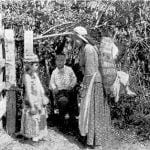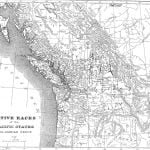When the United States authorities took charge of California in 1846 the military officers were especially interested in the Indians and protected them where possible. The Spanish mission authorities lived at peace with them, forcing them to labor, and their land holdings, when given, were held sacred.

The policy of the Mexican government in not recognizing the Indians right of occupancy to the lands seems to have been followed by the United States civil authorities, as no compensation has ever been made the California Indians for their lands except in the establishing and maintaining of certain reservations and agencies. The Indian reservations or otherwise, in other states and territories have been paid for the occupancy title to lands they have claimed. In 1849 the department authorized an agent to report upon the Indian tribes in California. In this report the agent states:
They have an indefinite idea of their right to the soil, and they complain that the pale faces are overrunning their country and destroying their means of subsistence. The immigrants are trampling down and feeding their grass, and the miners are destroying their fish dams. For this they claim some remuneration, not in money, for they know nothing of its value, but in the shape of clothing and food.
Congress provided, on September 28, 1850, 3 agents for the Indian tribes within the state of California. After these agents were appointed it was found that no appropriation had been made for their salaries and the necessary expenses of their agencies. Their functions as agents were therefore suspended; but, as there was an appropriation for negotiating treaties with the Indians in that State, they were constituted commissioners for that purpose. They were instructed, as commissioners, to conciliate the Indians and induce them to make and enter into written treaties with the government.
When the commissioners arrived in California the Indians, owing to the encroachments of miners and other settlers, as they reported, had fled to the mountains, leaving behind them their principal stores of subsistence, intending to return for them as necessity required. The white people in pursuing the Indians burned and destroyed all that fell in their way; consequently, at the time the different treaties were entered into the Indians of this region were without anything to subsist upon, even if left to range at liberty over their native hills. Under each treaty they were required to come from the mountains to their reservations on the plains at the base of the hills, and a superintendent of Indian affairs was appointed. Treaties were entered into with 80 or 90 bands of Indians, none of which were ever ratified, and a large number of reservations were established in different parts of the state under acts of Congress approved July 31, 1851, and March 3, 1855. The reservations were to contain not less than 5,000 nor more than 10,000 acres each. These were found too small, and an army of officers was required at great expense. In 1857 the reservations in California were reduced to 5, namely, Fresno Farm, Klamath, Mendocino, Nome Lackie, and Sebastian or Tejon. Under various pretenses the Indian lands were absorbed by the white people, and in some cases even the “reservation teams and fanning implements seized “.

In 1862 an agent from one reservation wrote to the Commissioner of Indian Affairs as follows:
The settlers have succeeded in destroying a large portion of the small grain, and the corn crop entirely. The corners of the fence had been raised, and chunks of wood put in, so that the largest hogs could walk in. When they had destroyed the crops the Indians were told that there was nothing for them to eat and that they would have to starve or steel, and if they did not leave they (the settlers) would kill them.
It was stated officially that “the sentiment of the great mass of the people of California, embracing every class in life, was all that the friends of the Indian could desire”; nevertheless serious disturbances occurred in various parts of the state consequent upon the unsettled status of Indian lands, and the white man usually prevailed. Finally Congress passed an act to provide for the better organization of Indian affairs in California on April 8, 1864 (13 United. States Statutes, page 39): Within 7 years after the passage of this law many of the reservations existing at the present time were established. The Indians of Fresno Farm and the Sebastian military reservation in Tejon valley were taken to the Tule River reservation. Many, however, quit reservation life, and cared for themselves. Those at Nome Lackie and Mendocino went to Round valley. Hoopa valley received many of the fighting Indians of northern California during the wars which followed the outbreak of the Indians of southern Oregon. There are now 23 reservations in the state, including the 19 Mission Indian reservations in southern California. The majority of the California Indians are practically self-sustaining, and rations were issued to only 175 poor and old Indians on reservations in 1890.
Indians In California In 1890

California came into the possession of the United States by capture in 1846 and cession from. Mexico under the treaty of Guadalupe Hidalgo of February 2, 1848. The provisions of that treaty extended over the Indians therein. The Spanish first occupied the lower part of California. The coast of California, and the foothills, from Klamath river on the north to Santa Barbara on the south and from the coast range of mountains to the coast, at the time of the Spanish occupancy was thickly peopled with many tribes, small or otherwise, along streams or on hunting; grounds, which had no linguistic affinities. (a) Many, if not most of them, have long since disappeared, while some are on reservations and tribal names are merged into general names. These Indians were generally fishers and hunters, while many were root diggers and nut gatherers. About the mountains of San Bernardino and to the extreme south the Digger or Mission Indians were found. These, were usually in bands of horn 200 to 300, each having its own dialect. The Spanish fathers forced the Indians to learn Spanish, being unable themselves to master the Indian dialects. These, Digger or Mission Indians were divided into two great tribes, the northern called the Coahuilas, the other the Southern Dieguenos. The Indians of California to the, north of the Mission country during the early mining days of California were sometimes most brutally treated by the white people and there were frequent murders without cause or provocation. They retaliated in kind, and many bloody and cruel affrays took place between them and the white people. These wars are still well remembered. 1

The Mission Indians at their best period were estimated at 30,000. It is not probable that the entire area of the present state of California contained at the date of its discovery by Europeans over 50;000 Indians. The California Indian was usually called the lowest mentally of all American Indians, and thought to be hopeless in the matter of attempted civilization; but in 1890, while there are 5,004: Indians on reservations in California, only 175 of them receive rations from the United States; and scattered throughout the state, living by their own efforts, and in nowise, connected with or under charge of the nation, are 11,517 of these same former much despised Digger and other Indians.
Citations:
- See The Native Races, volume I. by Hubert Howe Bancroft, for data and description of these tribes.[
]
